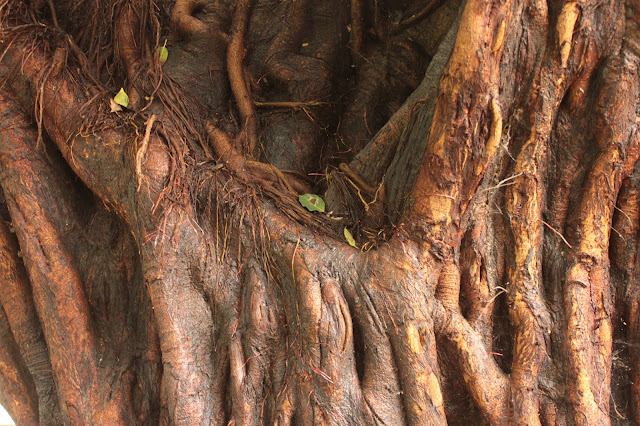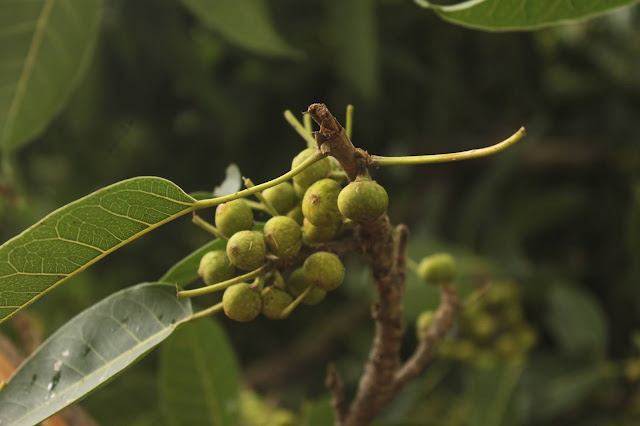Pakhad
The endearing presence of Pakhad trees
A slightly edited version of this piece finds place in Spectrum here. Thanks are due to the team at Deccan Herald.
Dheeraj Rathore, Kiran Keswani and Swati shared of the species over emails.
Scindhia and Shatrughan heard me on the species on multiple occasions and at strange times.
Don’t you tire talking about them? Asked a colleague as I expressed my awe and love – yet again - for the Pakhad trees. No, I responded. For, when around them I become a child and they my super heroes. The friend and I continued our late evening walk.
These Pakhad trees at the campus I stay on – Banaras, Uttar Pradesh – are a delight to the senses. Their size coupled with graceful presence often reminds me of elephants. The branches spread out like open arms – like godess Durga – only these are more. Branches, large yet gentle, and wrapped with leaves.
These trees were planted few decades ago, by someone wiser, to provide shade for the cows. I am yet to talk with the cows on the topic but colleagues have shared how they find these trees the best place to be under during the summers. They added that increasingly one sees and hears less and less of the species.
The state government too appears to have realized this. During 2019 it listed Pakhad as one of the species (with 28 other species) that could be felled only after permission. During 2021 the chief minister named it amongst the species to be accorded priority in plantation drives.
One does spot a few of these trees along the ghats in the town but for some reason neither is the Pakhad spoken of in the same vein as the Banyan or the Peepal nor is it as visible on the web. It does not merit space in the list of ‘State Trees’ either. Prof Uma Jaiswal, however, lists the species amongst the trees on the Banaras Hindu University campus adds that it is “sacred as per Vayu Purana”.
A paper in Sustainable Cities and Society, 2019, by Indra Jeet Chaudhary and Dheeraj Rathore, which discusses trees in urban areas recommends Ficus Virens for sustainable urban planning on account of its “higher dust holding capacity, moderate dust capturing capacity and least susceptibility to air pollution”. Another paper, this a global review on fig eating by vertebrate frugivores, in the Biological Review, 2001, lists Ficus Virens amongst the top 10 ficus species in terms of number of frugivore species recorded eating their figs. The number of frugivore species stands at 90.
I am not the only one who appears to be enamoured by the species. Mayank Austen Soofi, 2017, describes the tree which stands in the ruins of Feroz Shah Kotla as an “an unbeatable Sultan”. He adds that “the magnificent bloom of Pilkhan (another name) stole the entire limelight off the ruins”. They appear to be making their mark amidst history – especially in the National Capital Region. “There is a lovely specimen in the Humayun’s Tomb complex” write Ramesh Pathania and Himanshu Bhagat in Living Monuments. They add that “the Pilkhan peaks, so to speak, in April”. A website that lists heritage trees mentions one at the Deer Park as well. It eloquently describes the species thus, “A large fig tree, often with its roots wrapped around its trunk, that changes colour throughout the year as its leaves sprout, age, and fall”.
Pakhad appears to have been prevalent elsewhere as well. Pakri (yet another name!) is a name of more than a few villages – especially north of Vindhyas. Cursory googling led to half a dozen villages in Bihar alone. The search also led to John Christian’s article in The Calcutta Review, 1891, where he writes: “But the name, no doubt, was Ghur Phakri, or the village where the Pakhri tree stood on the ghur, which is the common fire place of the village, and where the villagers sit and gossip morning and evening in the cold weather, the fire being formed of the collected sweepings piled up in a place. The Pakhri tree spoken of here, from which the village took its name, was no doubt the one under which there was a village fire place (ghur)”.
Let us move to the species’ size. Description of a tree in Australia gives an idea of how massive the Pakhads can get, “The Curtain Fig Tree is approximately 50m high with a trunk circumference of 39m. The canopy extends in a radius of approximately 30m from the trunk of the tree. Extensive aerial roots, which are now thick and interwoven, drop 15m to the forest floor, forming a curtain oriented north-west to south-east over approximately 7m. The host tree has since rotted away and the fig is now a free standing tree”.
Coming back to the trees on campus. Seldom has another pair of trees appeared so endearing and shapely even after sunset. Its thick canopy darker than the darkness around. Its presence, in the dark, akin to that of a close friend – warm and comforting. My fascination persists – untouched by the laws of diminishing marginal utility.



Mast.
ReplyDeletethanks . . wonderful to be amidst these indeed . .
Delete